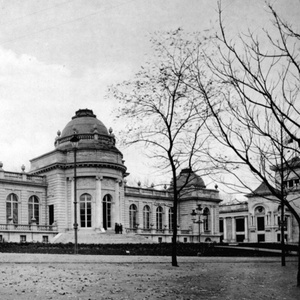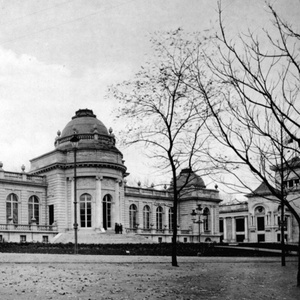History of the Musée des Beaux-Arts
The idea of creating a museum in Liège dates back to the Renaissance, at the instigation of Prince-Bishop Érard de la Marck (1472-1538), who sent his resident artist, Lambert Lombard, to Italy to build up a collection. The project was aborted.
The end of the 18th century, and especially the 19th century, saw the growth of the town's collections. They were successively housed in various locations: the Hôtel de Ville, the former church of Saint-André (from 1836 to 1860), the Halle aux Drapiers (from 1860 to 1903), before the collections were housed in the very first Musée des Beaux- Arts.
The ashlar building was constructed in 1903 in the rue des Anglais, in perfect harmony with the Académie des Beaux-Arts, housed in a neo-classical building dating from 1895. This proximity encouraged contact between the two institutions, with the director of one often serving as the curator of the other.
A few months later, at the other end of the city, in the Parc de la Boverie, the Palais des Beaux-Arts was inaugurated in 1905, a neo-classical building inspired by the Royal Museum of Central Africa in Tervueren, and built to host the Universal Exhibition organised in Liège. It was used for temporary events and exhibitions for almost fifty years, before finally fulfilling its true museum function.
The emergence of a Walloon identity
In Liège, as in other Walloon cities, the first half of the 20th century was marked by the exaltation of Walloon sentiment, supported by figures such as Jules Destrée and Auguste Donnay. In 1949, the idea of a museum devoted to Walloon art was born: "We think it would be more interesting to classify our collections in a different way, i.e. at the Academy we would have Belgian art [...] i.e. everything that is not specifically Walloon art, foreign art and in particular our important French collections [...] Walloon production, at its best, obviously expresses a very particular sensibility. It had never had the opportunity to express itself so fully", said Jules Bosmant, curator of both the Musée de l'Art wallon and the Musée des Beaux-Arts. This separation of the collections into two distinct entities was a milestone in the history of the municipal museum. The works of Walloon art moved from the rue des Anglais to the Palais des Beaux-Arts: the Museum of Walloon Art was inaugurated on 3 May 1952. 1952 also saw the creation of the Cabinet des Estampes et des Dessins (Prints and Drawings Room), designed to bring together in a single location the works on paper that were scattered and kept in various places: the Archaeological Museum, the Musée d'Ansembourg, the Academy and the Bibliothèque communale des Chiroux.
Since 1945, intellectual life in the Cité ardente has also benefited from the dynamism of the Fine Arts section of the A.P.I.A.W. (Association pour le progrès intellectuel et artistique de la Wallonie). Its members include such well-known figures from Liège as Fernand Graindorge, Marcel Florkin, Ernest Van Zuylen and Ernest Schoffeniels. On its own or in partnership with the museums of Liège, the A.P.I.A.W. is keen to offer a wide range of events, conferences and exhibitions by contemporary artists, both from Wallonia and abroad, particularly France. In many cases, the A.P.I.A.W. will forge links that will prove decisive in the acquisition of artists' works for the municipal collections.
During the 1970s, Liège underwent a period of major redevelopment work north of Place Saint-Lambert, to make way for the construction of a dual carriageway, which led to the demolition of several buildings. The Musée des Beaux-Arts adjoining the Académie was demolished.
New premises had to be found to house the collections, which had grown substantially. A new museum complex was therefore built in a neglected area, the Saint-Georges district between La Batte and rue Feronstrée. The building, designed by architect Henri Bonhomme, is close to the municipal administrative services and features concrete architecture. It will house the Walloon art collections transferred from La Boverie. Inaugurated in 1981, it was renamed the Museum of Walloon Art and Cultural Evolution of Wallonia.
From ancient art to modern and contemporary art
A game of dominoes ensues. The fine art collections, not including Walloon art, are housed in the Palais des Beaux-Arts at La Boverie. But this venue is primarily dedicated to modern art, whose collections have recently been substantially enriched. The Musée d'Art Moderne de Liège was inaugurated in 1981. The collection of ancient art, comprising some eight hundred paintings from the 16th, 17th and 18th centuries, was no longer on public display. The Cabinet des Estampes (Prints and Drawings Department), which had occupied the premises since 1952, kept its discreet location in a wing of the building.
The building required major restoration work, which led to its closure for five years, from 1988 to 1993. When it reopened, the museum opened its doors to contemporary art and adopted a new name, MAMAC, Musée d'Art Moderne et d'Art Contemporain.
The split between fine art and Walloon art was to last until 2011, when the collections of the MAMAC, the CED and the collection of ancient art joined the Walloon art collections in the îlot Saint-Georges, recreating the entire fine art collections a century later.
After five years of restoration, refurbishment and extension work, the majestic 1905 palace at La Boverie is finally ready, 111 years after its construction, to house the new Musée des Beaux-Arts de Liège.



